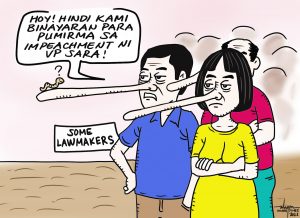By Herman M. Lagon
FEW EVENTS in the country are as dazzling as Iloilo City’s Dinagyang Festival. At the heart of this pulsating celebration stands Dagoy, a mascot and a cultural symbol next to Señor Sto. Niño, who embodies the spirit of the festival and the pride of the Ilonggos. The Dinagyang Festival, renowned for its spectacular Ati-Ati dance performances, rhythmic drumbeats, and vibrant street parties, owes much of its public allure and charm to Dagoy, a towering, six feet nine inches-tall mascot who has become an inseparable part of the festivities.
Introduced in 2004, Dagoy was initially a caricature used for promotional materials. His creation was a collaborative effort, reflecting the community’s imagination and desire to personify the spirit of Dinagyang. Inspired by his adopted daughter, Manila artist Chris Bayani sketched Dagoy, which later became the festival’s official mascot, his visage gracing posters, t-shirts, and streamers, creating a tangible connection between the festival and its audience.
Dagoy’s role extends beyond mere representation. He is a bridge between generations, an engaging figure for children, and a nostalgic emblem for older attendees. His appearance, sporting a fiberglass headdress with the Sto, encapsulates the festival’s essence. Niño’s image, adorned in black and gold with a camel-colored bahag, reminiscent of the traditional Ati attire. Every year, Dagoy’s costume transforms, mirroring the attire of the best-dressed tribe from the festival. This not only keeps his image fresh and dynamic but also honors the creativity and effort of the festival’s participants.
The significance of Dagoy in Dinagyang cannot be overstated. He symbolizes joy and welcome, an ambassador of the festival’s spirit. When Dagoy shakes a hand, it is as if he is extending an invitation to experience the warmth and exuberance of Iloilo City. His presence at various city events and Dinagyang-related activities heighten awareness and anticipation for the festival. It is a reminder of the community’s shared heritage and a call to celebrate it together.
Interestingly, Dagoy’s color change from black to brown in 2008 sparked considerable debate. This shift was more than a mere aesthetic choice; it was a statement about identity and uniqueness. While sharing similarities with other festivals like Ati-Atihan, Dinagyang sought to carve its own identity, and Dagoy’s transformation was a visual and realistic representation of this desire. It highlighted the festival’s evolution and its continuous effort to stand out in the rich tapestry of Filipino cultural celebrations.
Dagoy’s presence is a testament to the power of symbolism in cultural events. He embodies the values of the Dinagyang Festival–unity, vibrancy, and a deep reverence for cultural heritage. More than just a mascot, he is a storytelling tool, narrating the story of the Ilonggos, their past, present, and aspirations for the future. Through Dagoy, the festival transcends its role as a mere annual event; it becomes a living, breathing embodiment of Iloilo’s culture and history.
This mascot’s influence extends beyond the geographical confines of Iloilo. Dagoy has traveled to various places, promoting the Dinagyang Festival and, by extension, Iloilo City and even the Province of Iloilo. His jet-setting adventures have taken him to Metro Manila, Dagupan, Santiago, Tagbilaran, and Nueva Ecija, among others. Each appearance in television shows and public events is not just a promotion but an education about the rich cultural fabric of our country, spotlighting Iloilo’s unique contribution.
The impact of Dagoy on the festival’s success is also significant from a tourism and economic perspective. The Dinagyang Festival has garnered recognition as the “Best Tourism Event” for consecutive years, a testament to its appeal and the effectiveness of its promotions, with Dagoy and Señor Sto. Niño is at the forefront. The UN Development Program’s grant and the Asian Development Bank’s recognition further emphasize the festival’s role in promoting sustainable cultural tourism and local development goals.
Looking forward, introducing innovations like school-based tribe participation and other changes in the Dinagyang Festival signal a new era of inclusivity and creativity. Dagoy, as the festival’s face, will continue to play a pivotal role in these developments, evolving with the festival and continuing to be a source of joy and pride for the Ilonggos.
Dagoy is more than just a mascot; he is a cultural icon, a bearer of tradition, and a catalyst for community engagement. His existence enriches the Dinagyang Festival, making it a celebration of faith and culture and a showcase of the dynamic and resilient spirit of the Ilonggos. As Dagoy continues to evolve and inspire, he remains a beloved symbol, a reminder of the joy and unity that festivals like Dinagyang bring to the world.

